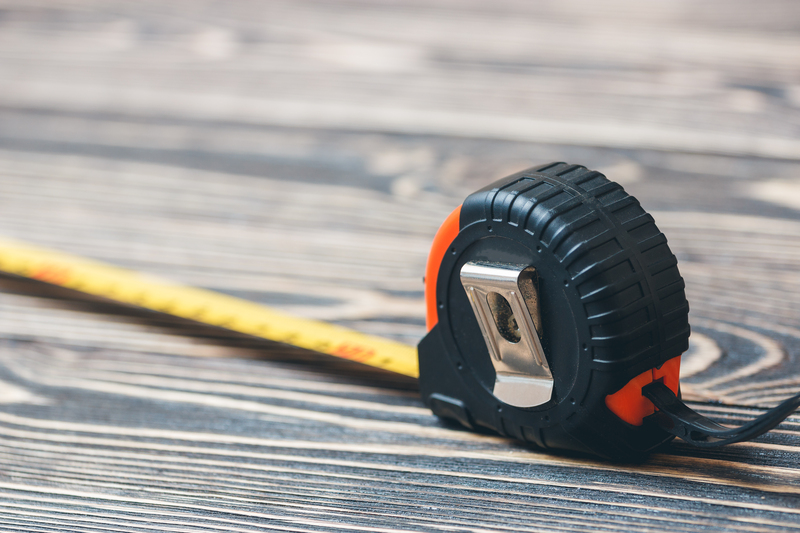Essential Tips for Properly Storing an Unused Freezer
Posted on 18/05/2025
Essential Tips for Properly Storing an Unused Freezer
Have you found yourself with a freezer you don't need right now? Whether you've upgraded to a new appliance, downsized your household, or simply found yourself with an extra freezer, knowing how to store an unused freezer is crucial to keeping it in excellent working order. Improper storage can result in unpleasant odors, mold, electrical issues, or even permanent damage--impacting its performance and your investment. In this comprehensive guide, we'll explore the best practices for safely and efficiently storing your unused freezer, with tips and steps you can use for short-term and long-term storage.
Why Proper Freezer Storage Matters
When not in use, a freezer can suffer damage from neglect, moisture, pests, or poor storage conditions. Paying attention to the storage procedures ensures your appliance remains functional, aesthetically appealing, and safe to use again. Storing a freezer properly also helps prolong its lifespan, prevents unwanted repair costs, and maintains energy efficiency when it's time to use it again.
The Risks of Neglecting Unused Freezers
- Odor Build-Up: Leftover moisture and trapped food particles can create mold and mildew, causing foul odors.
- Electrical Problems: Moisture and dust accumulation can impact wiring and electronic controls.
- Physical Damage: Dents, scratches, and broken seals may result from improper positioning or exposure.
- Energy Inefficiency: Freezers that aren't cleaned and maintained drain more power and cost more in the long run.
- Pest Infestation: Unattended freezers may attract rodents and insects, especially if stored with traces of food.
Now that you understand the importance, let's get into the step-by-step process of storing your unused freezer safely.

1. Thoroughly Clean Your Freezer
Step 1: Defrost Completely
Before placing your freezer into storage, ensure it is completely defrosted. Unplug the unit and leave the door open to let ice melt naturally. You can speed up the process by placing bowls of hot water inside. Wipe away pooling water periodically to avoid water damage.
- Remove all food contents and store perishables elsewhere.
- Allow ice to melt naturally.
- Use towels to soak up excess water.
Step 2: Clean and Disinfect
Once defrosted, thoroughly clean the interior and exterior. Use a mild detergent or a mixture of water and baking soda (recommended ratio: 2 tablespoons of baking soda per quart of water) to scrub shelves, walls, door seals, and drawers. Rinse and dry with a soft cloth. Pay special attention to rubber gaskets and hidden crevices where food particles may be trapped.
- Sanitize surfaces to prevent odor and bacteria growth.
- Dry all surfaces thoroughly to avoid mold.
- For stubborn stains, try a solution of vinegar and water.
Step 3: Deodorize
Even after cleaning, it's smart to leave a deodorizer inside the freezer. Place an open box of baking soda or a few activated charcoal briquettes inside with the door propped open while the unit air dries. This absorbs lingering odors and maintains freshness.
2. Prepare the Freezer for Storage
Step 1: Remove and Secure Shelves
All removable shelves, bins, and drawers should be taken out, cleaned, and dried separately. Store them inside the freezer only when absolutely dry, or wrap them in clean cloth and keep them alongside the unit.
- Label removable parts for easy reassembly.
- Wrap fragile glass shelves in bubble wrap.
Step 2: Protect Door Seals and Gaskets
Inspect door seals (gaskets) for any cracks or wear. If damaged, consider replacing them before storage to prevent further deterioration. Apply a thin layer of petroleum jelly or food-grade silicone lubricant to seals to prevent drying and cracking during extended storage.
Step 3: Prop the Door Open
Never store a freezer with the door tightly shut! Doing so traps moisture inside, which may cause mold, mildew, and lingering odors. Use a wedge, door stopper, or rolled towel to hold the door slightly open, allowing for continuous air circulation.
3. Select the Right Storage Location
Factors to Consider
- Temperature and Humidity: Store the freezer in a cool, dry environment. Excess humidity or extreme temperatures (hot or cold) can damage electronic components and seals.
- Flat Surface: Ensure the unit is placed on a level surface to prevent stress or warping of the frame and compressor.
- Protection from Elements: Avoid direct sunlight, rain, snow, or areas prone to flooding.
- Pest Control: Keep the area clean and free from food debris that might attract pests.
- Ventilation: Allow a few inches of clearance around the freezer for air movement, which helps prevent condensation and corrosion.
Where to Store an Unused Freezer
Ideal storage locations include:
- Garage: If not subject to extreme temperatures.
- Basement: Provided it's dry and well-ventilated.
- Climate-Controlled Storage Unit: Ensures optimal temperature and humidity levels.
- Utility Rooms or Sheds: As long as they're insulated and secure.
Avoid storing your freezer outdoors (unless it's designed for outdoor use) or in uninsulated areas prone to moisture, which can cause rust and electrical faults.
4. Positioning and Protection During Storage
Store Upright or Chest Style? The Right Orientation Matters
Store your freezer in its normal upright or chest position--never on its side or back. This prevents compressor oil from leaking out and ensures the appliance remains structurally sound. If you must move the unit on its side, allow it to sit upright for several hours before using it again.
- Secure locks or latches with duct tape or string to prevent accidental closing.
- Label your stored freezer clearly to avoid confusion or accidental opening.
Cover for Extra Protection
Cover the freezer loosely with a breathable cloth or sheet. Avoid plastic covers that trap moisture, potentially leading to rust or mold growth. The cover will shield the appliance from dust, debris, and accidental scratches.
5. Maintain Your Freezer in Storage
Regular Checks Make a Difference
- Monthly inspections are advisable. Check interior and exterior for any signs of mold, leaks, rust, or pest activity.
- Refresh deodorizers as needed if you notice mustiness.
- Ventilate the area and wipe down surfaces periodically to avoid moisture buildup.
Long-Term Storage Considerations
If storing for more than 6 months, revisit every 2-3 months. If the freezer is stored in a location with fluctuating temperatures, you might need to increase the frequency of inspections.
- Ensure no critters have made a home inside.
- Double-check seals, as dry rot or cracking can develop over time.
6. Preparing to Use Your Freezer Again
How to Safely Reactivate an Unused Freezer
- Reinstall all removable shelves and bins after a fresh clean and dry.
- Inspect electrical cables thoroughly for any signs of wear, fraying, or pest damage.
- Plug in the appliance and allow it to run empty on the coldest setting for several hours to ensure it reaches and maintains the proper freezing temperature.
- Double-check gaskets/seals for flexibility and integrity before loading with food items.
Frequently Asked Questions about Storing an Unused Freezer
- Can I store a freezer unplugged?
- Yes, storing a freezer unplugged is preferred for unused appliances. Always ensure the door is propped open to avoid mildew and odors.
- How do I prevent mold in an unused freezer?
- Clean and disinfect the freezer thoroughly, ensure it's completely dry, and store with the door slightly open with a deodorizer inside to prevent mold growth.
- Is it safe to store my freezer in the garage?
- It's safe if your garage is dry and doesn't experience extreme heat or cold. Otherwise, consider a more climate-controlled option.

Quick Reference: Checklist for Storing Unused Freezers
- Defrost and clean thoroughly
- Dry all parts and surfaces
- Deodorize and prop door open
- Remove or secure loose parts and shelves
- Apply lubricant to seals/gaskets
- Store in a cool, dry, well-ventilated space
- Cover loosely for dust protection
- Conduct regular inspections
Conclusion: Keep Your Freezer Trouble-Free for Future Use
Taking time to properly store your unused freezer pays off in the long run. Each step, from thorough cleaning to regular maintenance checks, helps maintain your freezer's condition and performance. Following the essential tips for storing freezers that aren't currently in use not only extends the life of your appliance but also gives you peace of mind knowing it will work efficiently when it's time to use it again.
Remember: A little preparation and regular attention prevent costly repairs, unwanted odors, and unnecessary stress. With these expert guidelines, you're equipped to handle the safe storage of unused freezers--so next time you need extra space for frozen foods, your appliance will be ready to serve you in top shape.
Have other appliances to store? Visit our other guides for more tips on maintaining your household equipment year-round!



